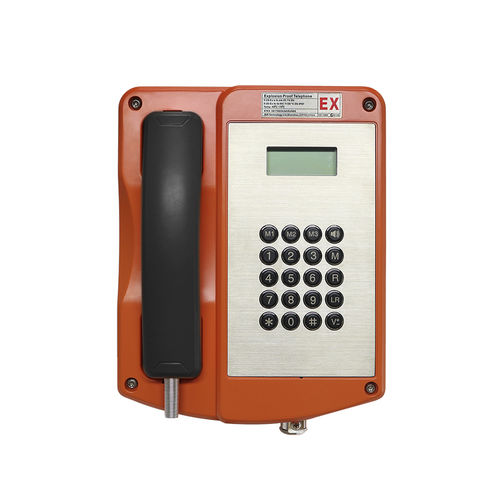
#Industry News
How To Select A Suitable EXPLOSION PROOF TELEPHONE?
Distinguish the types of environmental hazardous gases
1. Determine the presence of environmental hazardous gases
CLASSⅠ(Flammable Gases, Vapors or Liquids)
Area Classification
Division 1:
Where ignitable concentrations of flammable gases, vapors or liquids can exist all of the time or some of the time under normal operating conditions.
Division 2:
Where ignitable concentrations of flammable gases, vapors or liquids are not likely to exist under normal operating conditions.
Zone 0:
where ignitable concentrations of flammable gases, vapors or liquids are present continuously or for long periods of time under normal operating conditions.
Zone 1:
Where ignitable concentrations of flammable gases, vapors or liquids are likely to exist under normal operating conditions.
Zone2:
where ignitable concentrations of flammable gases, vapors or liquids are not likely to exist under normal operation conditions.
2. Distinguish the types of environmental hazardous gases
Groups
Division 1 and 2 Zone 0, 1 and 2
A(acetylene) IIC (acetylene & hydrogen)
B (hydrogen) IIC (acetylene & hydrogen)
C (ethylene) IIB (ethylene)
D (propane) IIA (propane)
3. Telephone max. surface temperature(less than gas ignition temperature)
Temperature classes
Division 1 and 2: Zone 0, 1 and 2:
T1 (≤450°C) T1 (≤450°C)
T2 (≤300°C) T2 (≤300°C)
T2A (≤280°C) -
T2B (≤260°C) -
T2C (≤230°C) -
T2D (≤215°C) -
T3 (≤200°C) T3 (≤200°C)
T3A (≤180°C) -
T3B (≤165°C) -
T3C (≤160°C) -
T4 (≤135°C) T4 (≤135°C)
T4A (≤120°C) -
T5 (≤100°C) T5 (≤100°C)
T6 (≤85°C) T6 (≤85°C)
4. Equipment protection methods and corresponding marks
4.1 International Protection Techniques (Equipment Protection Levels) 4.2 North American Protection Techniques
Zone0:
• Intrinsic safety,"ia"(Ga)
• Encapsulation,"ma"(Ga) or
"m" for CAN
• Class I,Div 1 intrinsic safety
Div.1:
• Intrinsic safety
• Explosionproof
• Purged/pressurized (Type X or Y)
• Any Class I, Zone 0 technique
Zone1:
• Flameproof,"d"(Gb)
• Pressurization,"px" or "py"(Gb)
or "p" fo4 CAN
• Powder filling,"q" (Gb)
• Oil immersion,"o" (Gb)
• Increased safety,"e"(Gb)
• Intrinsic safety,"ib"(Gb)
• Encapsulation, "mb" (Gb) or
"m" for CAN
• Any Zone 0 technique
• Any Class I, Div 1 technique
Div.2:
• Hermetically-sealed
• Non-incendive
• Non-sparking
• Purged / pressurized (Type Z)
• Sealed
• Any Class I, Division 1 technique
• Any Class I, Zone 0,1 or 2 technique
Zone2:
• Pressurization,"pz"(Gc) or
"n" for CAN
• Intrinsic safety,"ic"(Gc) or
"n" for CAN
• Encapsulated,"nC"(Gc)
• Enclosed-break,"nC"(Gc)
• Energy-limited,"nL"(Gc)
• Hermetically-sealed,"nC"(Gc)
• Non-incendive,"nC"(Gc)
• Non-sparking,"nA"(Gc)
• Restricted breathing,"nR"(Gc)
• Sealed,"nC"(Gc)
• Encapsulation,"mc"(Gc) or
"n" for CAN
• Any Zone 0 or 1 technique
• Any Class 1, Div 1 or 2 technique
5. Determine the presence of dust
CLASⅡ(Combustible Dusts)
Area Classification
Division1:
Where ignitable concentrations of combustible dust can exist all of the time or some of the time under normal operating conditions.
Division 2:
Where ignitable concentrations of combustible dust are not likely to exist under normal operating conditions.
Zone 20:
Where ignitable concentrations of combustible dust or ignitable fibers/flyings are present continuously or for long periods of time under normal operating conditions.
Zone 21:
Where ignitable concentrations of combustible dust or ignitable fibers/flyings are likely to exist under normal operating conditions.
Zone 22:
Where ignitable concentrations of combustible dust or ignitable fibers/flyings are not likely to exist under normal operating conditions.
6. Distinguish the type of dust
Groups
Division 1 and 2: Zone 20, 21 and 22:
E (metal dust - Div. 1 only) IIIC (conductive dust)
F (carbonaceous dust) IIIB (non-conductive dust)
G (non-conductive dust) IIIB (non-conductive dust)
- IIA (combustible flyings)
7. Telephone Max. Surface Temperature
Temperature Classes
Division 1 and 2: Zone 20, 21 and 22:
T1 (≤ 450°C) None.
T2 (≤ 300°C) ----------------------------
T2A (≤ 280°C) Note: For Zone 20, 21
T2B (≤ 260°C) and 22, equipment
T2C (≤ 230°C) shall be marked to
T2D (≤ 215°C) show the operating
T3 (≤ 200°C) temperature
T3A (≤ 180°C) (maximum surface
T3B (≤ 165°C) temperature)
T3C (≤ 160°C)
T4 (≤ 135°C)
T4A (≤ 120°C)
T5 (≤ 100°C)
T6 (≤ 85°C)
8. Equipment protection methods and corresponding marks
8.1 International Protection Techniques (Equipment Protection Levels)
Zone 20:
• Enclosure, "ta" (Da)
• Intrinsic safety, "ia" (Da)
• Encapsulation, "ma" (Da)
• Any Class II, Div 1 technique
8.2 North American Protection Techniques
Div.1
• Intrinsic safety
• Dust-ignitionproof
• Pressurized
• Any Zone 20 technique
Zone21:
• Enclosure, "tb" (Db) or "t" for USA
• Pressurization, "p" (Db)
• Intrinsic safety, "ib" (Db)
• Encapsulation, "mb" (Db)
• Any Zone 20 technique
• Any Class II, Div 1 technique
Div.2
• Dust-tight
• Hermetically-sealed
• Non-incendive
• Pressurized
• Sealed
• Any Class II, Division 1 technique
• Any Zone 20, 21 or 22 technique
Zone 22:
• Enclosure, "tc" (Dc)
• Pressurization, "p" (Dc)
• Intrinsic safety, "ic" (Dc)
• Encapsulation, "mc" (Dc)
• Any Zone 20 or 21 technique
• Any Class II, Div 1 or 2 technique
Explosion-proof area classification reference
FOR EXAMPLE( Explosion poof telephone certification standard)
II 2G Ex eb ib [ib Gb] mb IIC T6 Gb
II 2D Ex ib [ib Db] tb IIIC T80 °C Db IP66
II: for surface industry
2: Permitted in Zone 1 and Zone 21
G: gas
D: dust
Ex: Denotes explosion protection
eb: Increased safety
tb: Enclosure protection
ib Gb: Intrinsic safety
ib Db: Intrinsic safety
mb: Encapsulation
ib: Intrinsic safety
IIC: acetylene & hydrogen
IIIC: conductive dust
T6: equipment surface temperature ≤85°C
IP66: ingress protection standard





